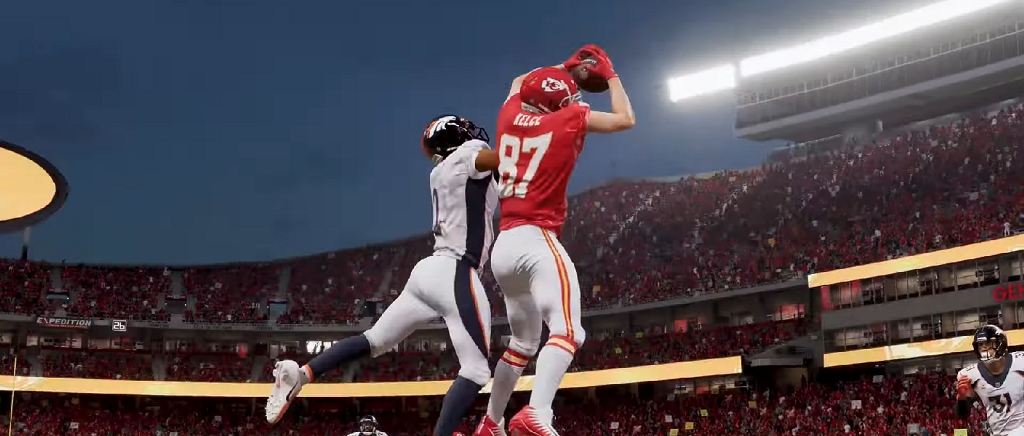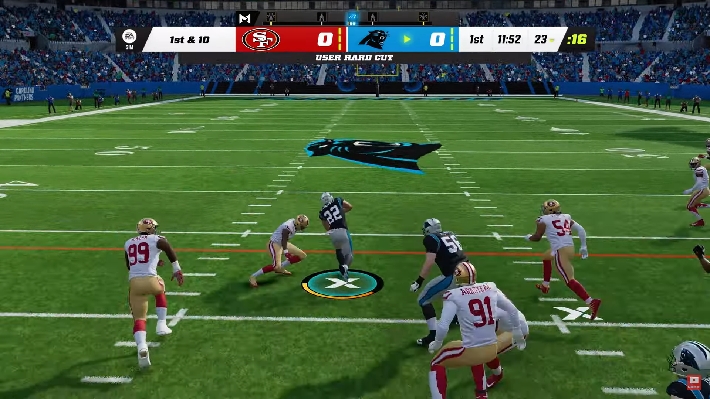
Madden 23 has revealed its cover and offered up a brief tease of its gameplay, and with that comes the usual cycle from fans where there’s initial excitement over a new Madden game followed swiftly by begs and jeers to make it “good this time.” Unfortunately, Madden has failed to meet fans expectations for the last few entries. The reason for this ranges from a dependency on Ultimate Team, launch day glitches, and a gameplay system that has grown stale.
While Ultimate Team isn’t going away anytime soon, and we’re going to have to wait until launch day to see how the game plays, we do know that EA Sports is working on adding some changes to the gameplay of Madden 23 to make it feel like a step in the right direction. Recently, we were able to head to EA Tiburon in Orlando, Florida where Madden 23 is in development, and get an early look at the game. We also got access to an early build of the game to try out some of the new gameplay features in Madden 23, but what we really have been focusing on though is their new big staple, FieldSENSE.
FieldSENSE delivers an all-new foundation for ultra-realistic gameplay & more control at every position
Preorder #Madden23 today

: https://t.co/gzUtCUN3Nc pic.twitter.com/I1D6bb4y8B
— Electronic Arts (@EA) June 6, 2022
FieldSENSE is the way Madden 23 is giving the player slightly more control over what is happening on the field. One of the big complaints of previous Madden games is how certain plays can feel like a slot machine playing out based on animations. Not to mention, players would interact with each other in sometimes unnatural motions. While these new animations have not made a perfect game, it paints the potential of a big improvement for the franchise and a great step into the next generation of consoles.
Hit Everything
The feature that probably is going to have the most impact on Madden 23 is what the developers are touting as “hit everything.” Essentially, pretty much anyone on the field can be hit at any point until the whistle was blown dead. An example of this would be on a play where a running back and a linebacker would collide with each other. Usually, based on some under the hood stuff, an animation for the play would be chosen and then it would play out and the play would end. What we would then see is players running up and then stopping instead of contributing to the tackle, or assisting the running back, until the animation played out. With hit everything, players now will run into the play and contribute to the action.
The feature doesn’t only play out in tackles though. It also takes place in pass plays, such as mid-air collisions, and even on the line in blocking scenarios. Tight ends now throw effective chip blocks to slow down rushers as they run out for routes. A player that is stumbling from chip blocks is less likely to make a tackle, or is more susceptible to a huge block from an incoming lineman. Of course, to counteract this blitzers on defense no longer have a slight delay, but instead take off the second the ball is snapped. Line up in an empty set if you want, but pass rushers can and will reach the QB without blocking help.
One area of frustration that hit everything did cause is that turnovers feel more frequent. This could be by design, because of my choice to fight for extra yardage, but there was one instance where my player got caught in an animation and fumbled the ball for a scoop and score because someone else came in and knocked it loose. Plays like that are going to frustrate players who feel like QB’s still fumble too easily.
Skill-Based Passing
Skill-based passing feels really good when it works, as every player has a catch radius where, if the ball lands in that radius, they’re almost guaranteed to make a play on the ball. However, the player can choose to utilize skill-based passing and choose where in the radius the ball lands making it easier to play keep away from defenders. This also creates a good skill gap between an accurate QB, like Aaron Rodgers, compared to a rookie like Matt Corral. If the player chooses they can have a meter on the bottom that, when it lands in the green, creates a more accurate pass and obviously players that are more accurate will have more green to work with.
Where skill-based passing gets really fun though is when the player chooses to put the ball outside the catch radius. If someone has Ja’Marr Chase and they throw a deep ball they can choose to put it in the catch radius, but there’s always a chance the corner is going to get there too, so what the player might want to do instead is put the marker farther outside that catch radius where they know only Chase can reach the ball with his incredible speed. If they place it just right, and Chase makes the grab, then that’s an easy TD. It adds a slight sense of skill where players that get really good can pick apart defenses.
Don’t feel obligated to use the game’s default settings either. The player can customize how far the marker can be moved from the catch radius, the sensitivity of the marker, if they want to have an accuracy meter, and if they want to use this feature in the first place. There’s even a slowdown option to help new players get used to using it, and if players don’t like skill-based passing then they can turn it off and go back to classic passing. This level of customization is really valuable for anyone that wants to create their own experience.
360 Cuts
360 Cut is probably the weakest of the FieldSENSE features. It’s not necessarily bad, but it feels very geared towards star players. An example of this can be seen in the trailer when Christian McCaffrey shrugs off a tackle while barely being touched by the safety.

Considering how skilled every running back is in the NFL these days, it feels a little unfair that stars can simply shrug off tackles while every down backs don’t get the same luxury. That said, the ability to break tackles is really only one part of the 360 Cuts feature. The real purpose of this is to let players make more direct movements with the ball.
In that sense, it works for the most part. It was definitely easier to redirect towards a hole in the line and not feel obligated to just push straight forward and hope everything works out. Kick returns also feel easier to dance through the coverage. Getting a good run game going still feels overly challenging sometimes, but this at least makes hitting the lane easier. The dream scenario for 360 Cuts, and this is where stars can really show their impact, is that eventually the really good running backs can dance behind the line and wait for a hole to open up the way Le’Veon Bell and David Johnson used to at their peak.
WR vs. DB Battles
It’s hard to say one way or the other how this is working so far. The build we were given at the moment only has Play Now and Play Online so there aren’t many ways to try out the game as a wide receiver or a corner. The AI would use the moves here and there, but it never felt particularly impactful although I did have one game where Stephon Gilmore ate Trevor Lawrence’s lunch, so maybe it was working better than I knew at the time. This is a feature we’re gonna have to come back to once more game features open up and we can play an experience meant for playing as an individual receiver or corner.
Note: Our build of Madden 23 is an incomplete version of the game for the PlayStation 5. While we were able to get early thoughts on FieldSENSE and the game itself, our experience was not a complete one.

